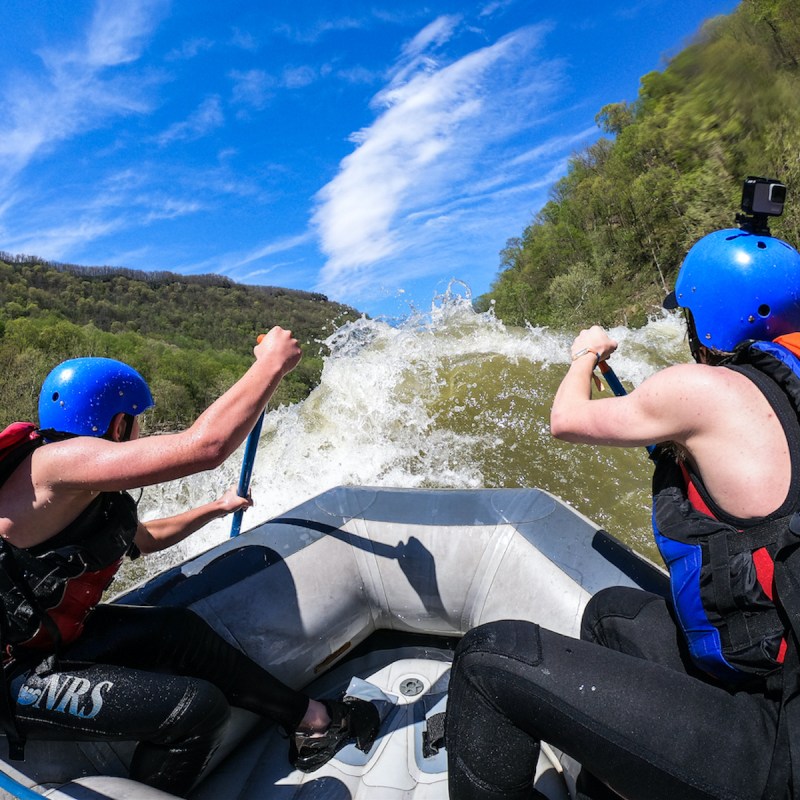
Five years ago, I took my first whitewater rafting adventure in the jungles of Costa Rica. It was a wild ride, with the raft being tossed by the waves like an ice cube in a cocktail shaker. Every minute of the ride was thrilling and my only concern was seeing another day. Our guide safely navigated the course while the rest of us paddled for our lives. Thankfully, we finished alive and thoroughly soaked to the bone.
Videos by TravelAwaits
It was my first attempt, but it wasn’t my last. The adrenaline rush was so memorable that I knew whitewater rafting was something I wanted to seek out time and time again. And so I have, both in the U.S. and abroad. For those who think whitewater rafting might be right up their alley, I highly recommend trying one of these rivers for a ride unlike any other.
Tips For Whitewater Rafting
One of the first things you learn about whitewater rafting is that everything depends on the water level. Most rivers rely on melted snow, so if there was limited precipitation the previous winter, there won’t be a lot of water, which can make rafting a bit challenging. The majority of whitewater rafting in the U.S. occurs during the summer months because it is too cold the rest of the year.
Every whitewater rafting adventure will have guides who ride along with the group. They will cover all of the safety rules before you even step foot on the raft. Stronger rowers sit at the front of the raft, helpers in the middle, and guide in the back.
In the beginning, there will be time to practice the different strokes. Whitewater rafting is for all fitness levels, but if there are any shoulder or back issues, I would avoid taking the trip.
Rapids are classified from Class I to Class VI, with Class I being the easiest and VI being the most dangerous (and best left to the experts). Be sure to confirm the types of rapids you will encounter on your trip.
Rafting companies will provide all the gear you need, including helmets, life vests, and paddles. It is recommended to apply plenty of sunscreen — as well as bring some along for later — and wear closed-toe water shoes for the best experience. Flip-flops are not allowed.
If you think you’re up for the adventure, here are some of our favorite spots to navigate in the U.S.

1. Riversport OKC
Oklahoma City, Oklahoma
Riversport OKC is a man-made whitewater rafting course in the middle of downtown Oklahoma City. The rapids here are between Class II and IV, and it’s a great place to learn the basics.
Riders will need to purchase tickets to the Riversport complex, but a ticket entitles you to two loops through the course in two separate time slots (four times in total). Each loop takes less than 10 minutes. Instructors will go through the rules and ensure your PFD (personal flotation device) fits correctly before setting off.
Pro Tip: This course is quick, but fun and you’re sure to get soaked. Be sure to bring a change of clothes and a towel. There are lockers available for storing your gear.

2. Colorado River Through Glenwood Canyon
Vail, Colorado
Vail, Colorado, is one of my favorite places to visit in the summer because it has endless opportunities for outdoor adventures. That includes the nearby Shoshone Rapids on the Colorado River. This is the headwaters of the river that ends in the Grand Canyon, but don’t let that stop you, this ride is all about fun.
Here you will find Class II and III rapids that flow through Glenwood Canyon. The ride starts out with quite a few rapids and all hands on deck but dissolves into a relaxing river float for the majority of the trip. This is a great starting point for first-timers or those traveling with children.
Pro Tip: This half-day adventure can be booked through several different companies in Vail or Beaver Creek. Book in advance to ensure there is space available because it tends to be very busy in the summer.

3. Truckee River
Lake Tahoe, California
The Truckee River runs from Lake Tahoe in California through Reno and onto Pyramid Lake in Nevada. Like many other mountain rivers, the flow depends on the previous winter’s snowfall. The water can be quite frigid in the summer, but it’s also refreshing.
Guided raft tours on the Truckee River cover about 7 miles and feature Class II and III rapids. Along the way, you’ll see mountainous terrain, abandoned railroads (including part of the original Continental Railroad), and possibly wildlife. This rafting adventure is another good option for beginners, and there are several stops along the way where you can hop off the raft and take a quick swim.
Pro Tip: Bring sunscreen to re-apply during this rafting trip. It lasts several hours and most of it is without shade.

4. Arkansas River Through Browns Canyon
Buena Vista, Colorado
The Arkansas River flows through Browns Canyon in central Colorado and provides a variety of experiences depending on the river’s water levels. Most tour operators are based out of nearby Buena Vista, Colorado, and before heading out, the company will tell you what to expect.
In this area, the Arkansas River has Class III and IV rapids. This means the current can be swift moving and sometimes difficult to navigate. It’s not impossible for beginners, but most will find it challenging.
The scenery along this river includes steep canyon walls and stacked boulders. There are parts of the river where you can take a quick dip and other sections where you need to be vigilant as you ride the waves. This is one thrilling experience you won’t soon forget!
Pro Tip: Those heading out late in the season (August), might encounter some shallow areas that require exiting the raft and carrying it a bit. It’s not as difficult as it sounds, but it is good to be prepared.

5. New River Gorge
West Virginia
Quite possibly the ultimate whitewater rafting adventure in the U.S. is found in West Virginia. New River Gorge is one of the newest national parks in the U.S., but whitewater enthusiasts have known about this place for years.
There are two main rivers for rafting: the New River and the Gauley River. The New River is divided into the upper and lower sections, with the upper featuring Class I to III rapids and the lower featuring Class IV rapids and above when the water is really flowing.
Navigating the Gauley should really be left to the experts as it features Class V rapids and more than 25 chutes to navigate. The Gauley River is the one place almost every river guide wants to attempt. Yes, guides can be crazy.
We opted for the Lower New River experience through Adventures on the Gorge because it has a good mix of action and relaxation. The raft drifted at times and we could admire the picturesque scenery, but there were other times we had to work hard and focus on the task at hand (not flipping the raft).
Pro Tip: For those newer to whitewater rafting, definitely start with the Upper New River. You will still have all the fun of rapids (Classes I to III) and stunning landscapes everywhere you look.
Whitewater rafting isn’t for everyone, but if you are a thrill-seeker and love a good jolt of adrenaline, this might be the answer. The first time I tried it, I was scared out of my mind, but now I look forward to the sense of accomplishment I feel once I’ve navigated each new course.
For more on our writers’ incredible adventures, check out these stories:
